
Business Management Solutions
Inclusive easy to use design!
(705) 849-6509
Pest - Information
Awareness of pests as well as how to prevent them so you can save money!
Ants

Ants do not feed on grass but the problem is the ant hills they make in the lawn. Ants can also be a problem when they come onto patios and indoors. Fortunately, ants can be controlled for a small period of time with a recommended insect control material. The insect control should be applied to the entire lawn. If only the ant hills are treated, the ants will move to an untreated area.
Black Turfgrass Ataenius
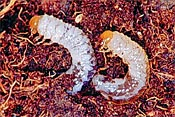
(A.K.A) Root feeding grub; adults consume soil high in organic matter. The adult is a small scarab beetle around 6mm in length that is common around high watered and fertilized areas. Grubs are very small, also 6mm in length. It is a native insect that has emerged as a turf pest in the last 30 years.
Bluegrass Billbugs
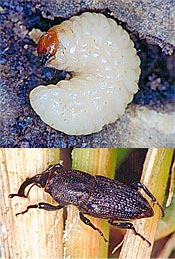
(A.K.A) Turfgrasses, stem-feeding larvae; Adult billbugs are long-snouted, 7mm long, gray-to-black beetles with a strongly tapered abdomen. They can be found walking on hard surfaces in spring prior to depositing eggs in grass sheaths. The plump, legless white larvae first feed inside the stems then on the crowns.
Chinch Bug
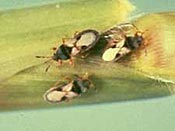
These bugs tend to gather on sunny open patches of turfgrass. Due to their small size, chinch bugs are hardly noticeable therefore it becomes a problem since they are considered pests that feed on stems of turfgrass.
Cutworm
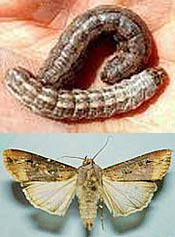
Cutworms are not worms, biologically speaking, but caterpillars; they are moth larvae that hide under litter or soil during the day, coming out in the dark to feed on plants. A larva typically attacks the first part of the plant it encounters, namely the stem, often of a seedling, and consequently cuts it down; hence the name cutworm.
European Chafer Grub
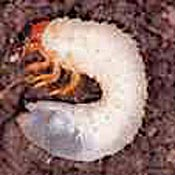
A beetle of the Scarabaeidae family. Formerly only found in continental Europe, this invasive species is now found at temperate latitudes in North America, where they are commonly called June bugs. The large, white grubs of R. majalis feed on the roots of most cool latitude grasses, both wild and cultivated. This has made the European chafer an enemy of North American lawns.
Japanese Beetle
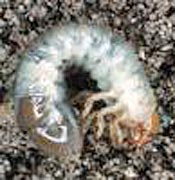
The Japanese beetle is highly destructive during both its larval and adult stages. The larval stage is responsible for the damage done to your lawn and the adult stage is more damaging to ornamental plants. The grubs are about 1" long when mature, white to cream colored, has a dark head, 6 legs and a C-shaped body. The lawn wilts, turns yellow then brown during August or September. The damaged grass will roll up easily. Damage to your lawn also occurs when moles, raccoons, skunks dig up your lawn looking for the grubs.
June Beetle
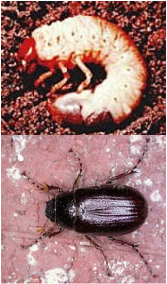
June beetles have a 3 year life cycle with grub damage usually occurring every 3 years. Adult June beetles are black or brown and are about 1" in length with long, spiny legs. The larvae are small when first hatched but can get to a length of 3 cm to 4 cm when full grown. They have a tan or dark brown head, 6 legs and have two parallel rows of spines. The grubs feed on the roots causing the lawn to wilt, turn yellow and die out in patches. The damaged grass will roll up easily.
Leather Jackets & Crane Flies
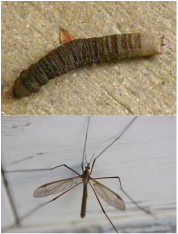
Due to their leathery grey brown skin, the damaging larvae are commonly referred to as "Leatherjackets". Leatherjackets feed during the day at or below the surface of the lawn. The damage to your lawn will first appear as brown patches that soon become bare if infestations are heavy. The insect is most visible on damp, warm nights when they feed on grass blades and stems at the soil surface. Life Cycle: The adult crane fly looks like a giant mosquito and appears in late summer. The female lays black eggs in the grass or soil and the eggs hatch within two weeks and the larvae begin to feed. They feed at the soil level on roots and seedlings almost continuously between August and late May. During the colder periods of winter, they burrow deep into the soil. As the temperatures rises in the spring, they will ascend to just below the soil surface and resume feeding.
Sod Webworm
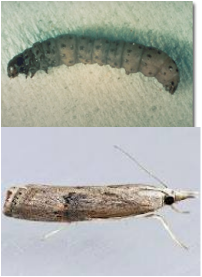
The sod webworm moth is small (1/2 inch long) and whitish-gray. They clasp or roll their wings close to their bodies when resting and have mouth parts projecting forward from the head like a snout. The moths are usually noticed when flushed out by people walking. They fly in a jerky zig zag manner and quickly return to the grass to hide. Around dusk, they may be seen flying a few feet above the grass and dropping their eggs. In a few days, these eggs and others laid on the lower parts of the grass stems hatch into small caterpillars. It is the caterpillar that damages the grass. The caterpillars generally have dark heads and rows of light-brown spots arranged in rings around the greenish-gray bodies. They live near the soil surface in silken shelters covered with bits of grass. The larvae clip off grass blades close to the ground and pull them back into their silken 'runways'. After several weeks of feeding they change into pupae and soon emerge as moths. Sod webworm can damage an area of lawn about the size of a softball. If the infestation is severe, the spots may coalesce into much larger areas. Wait 7 to 14 days after seeing peak moth flights and look for damage to the turf. Realize that an abundance of moths does not automatically mean damage. Also look for large numbers of birds, particularly starlings, pecking holes in the lawn looking for caterpillars. Control measures should be considered when you find 2 to 4 webworms per square foot of sod.
Turfgrass Scale
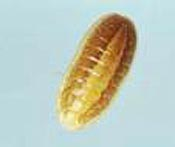
The turfgrass scale, is a new pest. Which has been found during the past several years in lawns. Adult scale is light tan in color with two dark stripes running parallel down their backs and measure about 1.5 mm wide and 2.5 mm long. The adults survive in the thatch layer and may cause minor damage. Large areas of your lawn may appear wilted and brown in color and does not respond to watering. Nymphs (young scale) appear in the late spring and summer and increase the damage as they are feeding off the grass. They look like pink pinhead size dots and are frequently spotted in large numbers clinging to grass blades.
